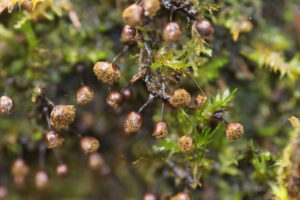
Article and images by Sarah Lloyd OAM
Tasmaniomyxa umbilicata was one of the first slime moulds I ever misidentified! To my inexperienced eye it looked like a Lamproderma, and even northern hemisphere experts who saw the fruiting bodies didn’t think otherwise.
Over the years, several potential type specimens (the specimen on which the description of a new species is based) were sent to a researcher in Spain, but they proved inadequate for microscopy because the spores had not matured properly. Meanwhile, the species was found in Victoria by fellow myxo enthusiast Peta McDonald who recognised the strange combination of characteristics and posted it on the slime mould Facebook page. It caught the attention of Professor Dmytro Leontyev who suspected it was a new genus, as it had a superficial resemblance to the family Lamprodermataceae, but other features reminiscent of another family, the Didymiaceae.
Several different genes were sequenced, with molecular data indicating that Tasmaniomyxa can be considered a ‘missing link’ between basal (i.e. primitive) limeless Physarales and the evolutionarily younger lime-containing members of the group. However, neither morphological nor available phylogenetic data allowed for the genus to be assigned to a described family, so that may be new as well.
One prerequisite when describing a new species is that it should be found at two separates locations at least 50 metres apart. This is to overcome the problem of the great variation within species caused by external conditions (e.g. weather) while the fruiting bodies are developing, leading to features that could be mistaken as distinctive characteristics of the species; something that has led to the same species being assigned multiple names. This requirement was easily met by the numerous collections from different places at my study site (i.e. Swamp, Big tree track and Thismia Gully) and collections made over many years.
Additional observations on iNaturalist from Tasmania and Victoria also fulfilled this prerequisite. T. umbilicatum has a bright yellow plasmodium and young fruiting bodies—known as ‘blebs’—that arise from plasmodia. Although there are other slime moulds with yellow plasmodia and blebs, they are rarely as brightly coloured, they occupy different substrates and are therefore unlikely to be confused with the new species. The many observations on iNaturalist indicate that T. umbilicata is common in wet forests and rainforest in southeastern Australia, and its preferred substrate is well decayed logs and stumps. They also confirmed its phenology, i.e. the time of year it appears.
One record from New Zealand on the Hidden Forest website, helped us to decide on the name ‘Tasmaniomyxa’: Tasmanio alludes to its distribution surrounding the Tasman Sea; myxa to the fact that it is a myxomycete.
The paper describing this unusual species includes field photographs taken over the past 13 years of the developing fruiting bodies, micrographs of spores and other features using a compound microscope, scanning electron microscopy, and extensive genetic sequencing. All this has revealed the mystery of this new genus in a paper that is considered “one of the most comprehensive descriptions of a new species of myxomycete” by one of the paper’s co-authors, Dr Martin Schnittler. This is not only because of the observations made over 13 years, but also because of the numerous records on iNaturalist, which can add so much to our knowledge of a taxon—whether plant, animal, fungus or myxomycete.
For more information visit
https://wordpress.com/post/sarahlloydmyxos.wordpress.com/3674


